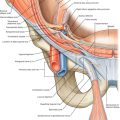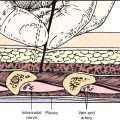CHAPTER 77
Quadriceps Tendinopathy and Tendinitis
Farshad Adib, MD; Christine Curtis, MD; Peter Bienkowski, MD; Lyle J. Micheli, MD
Definition
The quadriceps tendon is located at the insertion of the quadriceps muscle into the patella and functions as part of the knee extensor mechanism. Quadriceps tendinitis (or, as named in the more recent literature, tendinosis or tendinopathy) is an overuse syndrome characterized by repetitive overloading of the quadriceps tendon. The common mechanism of injury is microtrauma, in which the basal ability of the tissue to repair itself is outpaced by the repetition of insult [1]. Quadriceps tendinopathy often occurs in athletes participating in running and jumping sports as well as in persons who perform frequent kneeling, squatting, and stair climbing [2]. The superior strength, mechanical advantage, and better vascularity of the quadriceps tendon make quadriceps tendinopathy much less frequent than patellar tendinopathy [3].
Symptoms
Patients usually report an insidious onset of knee pain and may note painful clicking. Their chief complaint is usually “knee pain.” A burning sensation at the bone-tendon junction may be experienced [4]. The pain is aggravated by activity that challenges the extensor mechanism, including bending, stair climbing, running, and jumping. Reports of severe weakness, an inability to extend the knee, or the report of acute trauma with a “pop” should alert the clinician to the possibility of a quadriceps tendon partial or complete rupture. On occasion, a single episode of overload may elicit symptoms.
Physical Examination
On examination of the knee, point tenderness is localized along the superior pole of the patella and the quadriceps tendon. Quadriceps tendon pain may be elicited with extreme knee flexion and by resisted knee extension. The clinician should also be on the lookout for a palpable defect, suggesting partial rupture of the quadriceps tendon. Neurologic examination findings should be normal, with the possible exception of strength testing, which may be limited by pain or partial tendon rupture. Ligamentous examination of the knee is normal unless there is an internal derangement of the knee associated with trauma.
Functional Limitations
Quadriceps tendinopathy may interfere with activities of daily living. Pain is usually felt with stair climbing, kneeling, and rising from a chair. Athletes may be unable to participate in running and jumping activities.
Diagnostic Studies
Quadriceps tendinopathy is a clinical diagnosis, and diagnostic investigations are not generally necessary. If a partial tear of the quadriceps tendon is suspected but not apparent clinically, magnetic resonance imaging may be of assistance in confirming the diagnosis. Ultrasonography and Doppler study have also been found to be helpful [5].
Treatment
Initial
Initial treatment includes rest from aggravating activities. Activity modification should include protection from eccentric or high-load knee extension (e.g., going up and down stairs, bending, jumping). Proper warm-up and stretching should be conducted before activity. Also, the application of ice to the injured area for 20 minutes, two or three times daily and before and after athletics, can be useful. Nonsteroidal anti-inflammatory drugs may be used for pain and inflammation. In some instances, knee immobilizers are used but may promote weakness and disuse atrophy.
Rehabilitation
The main rehabilitation modality includes muscle strengthening and stretching. All muscle strengthening exercises are conducted in the pain-free range. Static exercises may be used to minimize compressive forces across the patellofemoral joint [2]. Eccentric strengthening exercises may be useful [6]. Therapeutic modalities including ultrasound, phonophoresis, and iontophoresis may be used [2]. The use of icing immediately after activity or work has been advocated [7]. A general conditioning program is recommended.
Procedures
Local corticosteroid injections are not typically done because of the risk of tendon rupture, but they may be necessary in some cases unresponsive to treatment. Care should be taken to inject circumferential to the tendon and not in the tendon itself.
Surgery
Quadriceps tendinopathy is mostly managed nonoperatively. Surgical intervention may be necessary in rare cases of partial rupture. Tendocalcinosis may reflect a chronic partial tear [8]. If partial tendon rupture is suspected, surgical consultation is advised.
Potential Disease Complications
Functional deterioration with the development of chronic symptoms may occur. A high level of functioning in patients with quadriceps tendinopathy is usually regained and maintained [2]. In rare cases of progressive microtrauma to the injured area, rupture of tendon may result.
Potential Treatment Complications
The complications related to the use of nonsteroidal anti-inflammatory drugs include the development of gastritis as well as renal and hepatic involvement. Corticosteroid injection may predispose the tendon to rupture. Repeated injections of corticosteroids may increase the risk for mucoid degeneration, fibrinoid necrosis, mineralization, fibroblastic degeneration, and capillary proliferation within the tendon [9].







